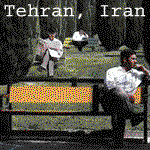Tibet Monks Disrupt tour by Foreign Journalists
 The first group of foreign journalists allowed into Tibet since anti-government riots broke out arrives at Lhasa Airport.
The first group of foreign journalists allowed into Tibet since anti-government riots broke out arrives at Lhasa Airport.“In the history of man, it has already been proved that the human will is more powerful than the gun.” -Dalai Lama
The government had arranged the trip for the reporters to show how calm Lhasa was after the deadly riots shattered China's plans for a peaceful run-up to the Beijing Summer Olympics.
The outburst by a group of 30 monks came as the journalists, including an Associated Press reporter, were being shown around the Jokhang Temple - one of Tibet's holiest shrines - by government handlers in Lhasa.
"Tibet is not free! Tibet is not free!" yelled one young Buddhist monk, who then started to cry.
They also said their exiled spiritual leader, the Dalai Lama, had nothing to do with recent anti-government riots by Tibetans in Lhasa, where buildings were torched and looted, and ethnic Han Chinese were attacked.
The government has said the March 14 riots were masterminded by "the Dalai clique," Beijing's term for the Dalai Lama and his supporters.
Government handlers shouted for the journalists to leave and tried to pull them away during the protest.
"They want us to crush the Dalai Lama and that is not right," one monk said during the 15-minute outburst.
"This had nothing to do with the Dalai Lama," said another, referring to the March 14 riots. The Chinese government says 22 people died, while Tibetan exiles say the violence plus a harsh crackdown afterward have left nearly 140 people dead.
The outburst by the monks came amid a morning of stage-managed events. Reporters had already been taken to a Tibet medical clinic that had been attacked nearby the Jokhang, and shown a clothing stores where five girls had been trapped and burned to death.
The monks, who first spoke Tibetan and then switched to Mandarin so the reporters could understand them, said they knew they would probably be arrested for their actions but were willing to accept that.
They had rushed over to stop the reporters from being taken into an inner sanctum of the temple, saying they were upset that a government administrator was telling the reporters that Tibet had been part of China for centuries.
They said troops who had been guarding the temple since March 14 were taken away the night before the visit by the reporters.
One monk said they were upset that some of the people brought to worship at the temple "are not true believers but are Communist Party members."
China rarely allows foreign reporters into Tibet under normal circumstances, so the media tour was meant to underscore the communist leadership's determination to contain any damage ahead of the Beijing Olympics in August that was supposed to celebrate China as a modern, rising power.
The official Xinhua News Agency reported Thursday on the action by the monks, but did not say what the monks yelled out. "The media tour soon resumed," Xinhua said.
The rioting and four days of protests that preceded it were the worst anti-Chinese demonstrations in Lhasa in nearly two decades and they sparked protests in Tibetan areas across a vast portion of western China.
On Wednesday, the first day of the visit, police presence was visible but not overbearing in the newly built up and heavily Chinese portions of Lhasa.
An acrid odor hung in the blocks near the old city where rows of burned out buildings stand as evidence of the violence. Many shops were closed, some from a lack of business, others from looting that left their migrant Chinese owners with little to sell.
Chinese state media and officials said Wednesday that more than 660 protesters have surrendered in Lhasa and in Sichuan province, site of at least two violent confrontations between police and Tibetan protesters.
The Chinese government has maintained its response was measured and comparable to what any responsible government would do when faced with civil unrest.
Labels: China, Dalai Lama, Media, Tibet














0 Comments:
Post a Comment
<< Home